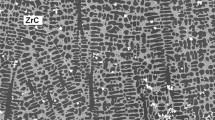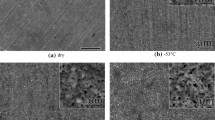Abstract
A model is proposed for the development of the first stage of the yield point return in Nickel 200. It is assumed that immediately after straining and unloading, vacancies cre-ated during deformation become trapped by interstitial carbon atoms. The carbon-va-cancy pairs thus formed then reorient quickly in the stress fields of nearby dislocations thus reducing the dislocation line energy so that dislocation pinning occurs. This model is based on a hypothesis proposed by Rose and Glover in 1966 for austenitic stainless steel.
Similar content being viewed by others
References
K. S. B. Rose and S. G. Glover.Acta Met., 1966, vol. 14, pp. 1505–16.
W. R. Cribb and R. E. Reed-Hill:Met. Trans. A, 1977, vol. 8A, pp. 71–76.
C. F. Jenkins and G. V. Smith:Trans. TMS-AIME, 1969, vol. 245, pp. 2149–56.
G. Schoeck and A. Seeger:Acta Met., 1959, vol. 7, pp. 469–77.
D. V. Wilson and B. Russell with an Appendix by J. D. Eshelby:Acta Met., 1959, vol. 7, pp. 628–31.
S. H. Carpenter: Ph.D. Dissertation, pp. 56–59, University of Utah, 1964.
0. P. Quist and S. H. Carpenter:Acta Met., 1975, vol. 23, pp. 321–28.
W. S. Owen and M. J. Roberts:Dislocation Dynamics, A. R. Rosenfield,et al. eds., pp. 357–79, Battelle Institute Colloquium, McGraw-Hill, 1967.
Y. Nakada and A. S. Keh:Acta Met., 1967, vol. 15, pp. 879–83.
H. Kressel and N. Brown:J. Appl. Phys., 1967, vol. 38, pp. 1618–25.
T. B.Gibbons and M. H. Brown:Scr. Met., 1975, vol. 9, pp. 15–16.
P. Ambrosi, E. Göttler, and S. Schwink:Scr. Met., 1974, vol. 8, pp. 1093–98.
D. Kuhlmann-Wilsdorf:Scr. Met., 1973, vol. 7, pp. 1059–64.
A. C. Damask and G. J. Dienes:Point Defects in Metals, Gordon and Breach, pp. 292–94, New York, 1963.
A. C. Damask and G. J. Dienes:Ibid. pp. 21–25.
P. Simson and R. Sizmann:Z. Naturforshg., 1962, vol. 17A, pp. 596–603.
A. Sosin and J. A. Brinkman:Acta Met., 1959, vol. 7, pp. 478–94.
D. M. Barnett and W. D. Nix:Acta Met., 1973, vol. 21, pp. 1157–68.
L. Zwell, E. J. Fasiska, Y. Nakada, and A. S. Keh:Trans. TMS-AJME, 1968, vol. 242, pp. 765–66.
F. R. N. Nabarro:Theory of Crystal Dislocations, p. 403, Oxford University Press, 1967.
C. S. Barrett and T. B. Massalski:Structure of Metals, pp. 235–37, McGraw Hill, New York, 1966.
Author information
Authors and Affiliations
Rights and permissions
About this article
Cite this article
Cribb, W.R., Reed-Hill, R.E. The initial development of a yield point due to carbon in nickel 200 during static strain aging. Metall Trans A 9, 887–890 (1978). https://doi.org/10.1007/BF02649831
Received:
Issue Date:
DOI: https://doi.org/10.1007/BF02649831




